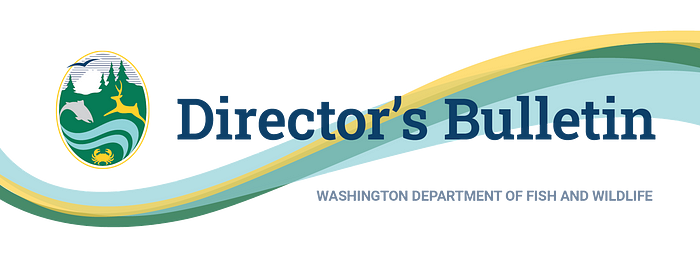Director’s Bulletin | Sept/Oct 2023
News and updates from WDFW Director Kelly Susewind

The bumper sticker stating that ‘Habitat is the Key to Wildlife’ is so true. Habitat is the combination of food, water, shelter, and the spatial arrangement and connectivity of those resources that allows fish and wildlife to thrive.
At the Washington Department of Fish and Wildlife (WDFW), we spend a lot of time working with partners to conserve habitat. Whether it is owning and managing wildlife areas, partnering with private landowners to provide technical assistance, or issuing hydraulic permits to protect aquatic life, our work to conserve habitat is critical to every aspect of our mission. Quality, abundant habitat is key to keeping common species common, recovering imperiled species, and providing sustainable hunting and fishing opportunities.
One of the major threats to fish and wildlife is human development and conversion of native habitat. The Office of Financial Management estimates that Washington’s population will grow from less than 8 million in 2024 to more than 10 million in 2051. With more structures and houses come more roads and more transmission lines, further fragmenting an already fragmented landscape.
That is why state statutes like the Growth Management Act and the Shoreline Management Act are so important. They provide guidance to local governments on land-use plans and development regulations, helping direct growth through zoning and adopting critical area ordinances to protect habitat features. These important tools help planners meet human needs while conserving areas for wildlife.
The Priority Habitats and Species (PHS) program is one of our primary means of translating fish and wildlife information from our resource experts into data and recommendations that local governments, conservation districts, landowners, and others can use to protect habitat.
The PHS program provides a suite of tools to help local governments designate and protect critical fish and wildlife areas. PHS manages a list and maps of species and habitats so that land-use planners, local governments, and landowners can assess potential impacts when making development decisions. PHS also provides management recommendations, so project proponents and land-use planners know how to protect priority species and habitats.
Priority species include state- and federally listed species, vulnerable animal groups (e.g., seabird concentrations or bat colonies), and vulnerable species of recreational, commercial, or tribal importance.
Priority habitats are habitat types or elements with unique or significant value to many species. A priority habitat may consist of a unique vegetation type like shrubsteppe, dominant plant species like juniper savannah, or a specific habitat feature like cliffs. There are 20 types of priority habitats in Washington. Three priority habitats have been in the spotlight recently; these include riparian management recommendations, shrubsteppe mapping, and biodiversity areas and corridors.
PHS is influential with local government land-use planners because it has been recognized by the state Supreme Court as a source of Best Available Science (BAS). Our regional habitat biologists do outstanding work to advise local governments how they can align their protections of critical areas with BAS and find the right balance to conserve species.
Want to learn more about PHS? Contact the PHS Section Manager Dr. Julia Michalak or visit the PHS pages on our website. As the state’s population continues to grow and put more pressure on habitat, the work the PHS teams do is critical and foundational to almost every aspect of our agency’s mission.
Sincerely,
Kelly Susewind, Director


Chronic wasting disease testing in eastern Washington
WDFW is once again asking hunters in the Eastern Region (Region 1 including Asotin, Columbia, Ferry, Garfield, Lincoln, Pend Oreille, Spokane, Stevens, Walla Walla, and Whitman counties) to have harvested deer and elk tested for chronic wasting disease (CWD), a fatal illness of deer, elk, caribou, and moose. CWD has not been detected in Washington but has been confirmed in four Canadian provinces and 30 U.S. states, including Idaho. Hunter check stations are staffed on weekends throughout the Big Game hunting season in Region 1, as that is the closest part of Washington to Idaho. Visit our webpage for check station locations and hours. Any hunter who has their deer or elk tested goes into a random drawing for a free multi-season deer tag for next year, courtesy of a partnership between WDFW and the Washington Chapter of Backcountry Hunters and Anglers.

Baker River sockeye reach record return through coordination by WDFW, tribes, Puget Sound Energy
A record number of Baker River sockeye made their way upriver this year. The sockeye co-managers — consisting of the Upper Skagit and Swinomish tribes and WDFW — are estimating a total return of more than 65,000 Baker sockeye for 2023. The Baker River is a tributary of the Skagit River. The sockeye run, which has been gradually on the upswing from a low of less than 100 fish in 1985, well exceeded the previous record of 51,074 fish trapped and harvested in 2015. Fish captured in the upstream fish trap, operated by Puget Sound Energy (PSE), are used to fulfill broodstock needs at WDFW’s Baker Lake Hatchery or are released to allow natural spawning and recreational fishing opportunity. Learn more about this successful conservation and fisheries collaboration between WDFW, Native American tribes, and PSE in our joint blog post with Northwest Indian Fisheries Commission.

New Habitat at Home content helps Washingtonians create spaces for birds, bats, and pollinators
In September, our Habitat at Home program published three new wildlife-specific resources for Washingtonians to create habitat where they live, work, and play. These online resources focus on creating habitat for three types of wildlife including Songbird Habitat, Pollinator Habitat, and Bat Habitat. Resources on the webpages are free and can be used by anyone, any business, or any school with a patio, balcony, rooftop, yard, or nearby greenspace. You can learn about beneficial plants, best practices, and wildlife viewing activities once your habitat is established. If you’d like to take your outdoor space a step further, you can also review certification requirements, either as an addition to your Habitat at Home plaque or as a standalone certification. Check the above webpages in early 2024 for the application. The Habitat at Home program is free and open to all Washington residents.

WDFW family fishing events host record-breaking year: volunteers sought for events next spring
Attendance at WDFW family fishing events continues to grow and 2023 was the biggest year in recent history, with nearly 5,000 attendees at more than two dozen events. WDFW began hosting youth fishing events in 1999 in partnership with local municipalities, community organizations and clubs, and volunteers. The events, held during spring and summer months, aim to educate the public, promote conservation, and help people learn how to fish. Participants learn about fish identification, water safety, fishing ethics, the basics of fishing gear and casting, and lessons in conservation. Plans are already in the works for the 2024 family fishing event season, which is expected to be the biggest yet with a goal of 20 events. Dates and locations will be posted at the start of the year. Check the youth fishing events page for more info and check out the volunteer page to learn about getting involved. You can also support youth fishing events in your community with a donation to the Youth Outdoors Initiative.

Invasive quagga mussels detected in Idaho; monitoring and prevention efforts ramp up in Washington
Last month, the Idaho State Department of Agriculture (ISDA) announced the presence of quagga mussels in the Snake River in the south-central area of that state near Twin Falls. These small but sturdy invasive mussels can clog pipes and mechanical systems of industrial plants, utilities, locks, dams, and hatcheries, as well as cause serious environmental damage to native aquatic species and habitats. ISDA initiated rapid response containment and treatment actions, and established a webpage for their incident response. A regional effort is now underway to ensure invasive mussels stay contained. If invasive freshwater mussels take hold in Washington, officials estimate it would cost more than $100 million each year to keep our power and water infrastructure running, in addition to causing ecological damage. Learn what WDFW’s Aquatic Invasive Species (AIS) unit is doing to monitor for and prevent the spread of invasive mussels in our recent blog post. In other invasive species news, we’ve published our latest European Green Crab Public Update, which includes detailed information on efforts by WDFW, tribes, and partners to control these harmful shore crabs on the Washington Coast, and in the Salish Sea where we’re seeing signs of progress.

Ballast water management protects Washington from aquatic invasive species
Of all the fish, wildlife, and habitat management, conservation, and outdoor opportunity responsibilities under our purview, ballast water monitoring is one many people may not know about. Yet ballast water management plays an important role in protecting Washington’s waters from harmful invasive species. Often outside the public eye, WDFW vessel inspectors and operations and data staff work hard to reduce the chances of invasive species entering our waters through ballast water — the additional weight large ships take on for stabilization. The Ballast Water and Biofouling Section of WDFW’s Aquatic Invasive Species Unit leads our ballast water management efforts. Learn more about them in this new blog post.

Anglers finding success during updated Lake Roosevelt sturgeon season
The Lake Roosevelt sturgeon season continues through November, and so far, it’s been a productive season for anglers. This fishery was changed from a summer season in past years to a fall fishery starting this year to reduce stress from warm water temperatures on sturgeon that are caught and released. This does not appear to have affected angler’s ability to catch these large fish. In the meantime, in October, WDFW staff stocked several thousand young white sturgeon in Lake Roosevelt for future generations of anglers to catch. At the rate these big fish grow, that could be a couple decades!

Radio-Activated Guard boxes help deter wolf-livestock conflicts
WDFW’s Wolf Advisory Group (WAG) will meet in Ellensburg Nov. 15 and 16 for their quarterly meeting. This meeting is open to the public to observe. Meeting agenda and location information will be posted to the Wolf Advisory Group web page. In other wolf news, this grazing season we utilized new Radio-Activated Guard (RAG) boxes sourced through a partnership between WDFW and Defenders of Wildlife. RAG boxes are placed around pastures to scare off carnivores. They play loud sounds and flash bright lights when approached by radio-collared wild animals. Because the RAG box design was never standardized and no one produced them consistently, they were hard to find. WDFW was down to one functioning box when it partnered with Defenders and other groups to design a more functional RAG box and work to have it produced on a consistent basis. You can read about the results from that partnership and get a look at the new and improved RAG box in this blog post.

WDFW renews Puget Sound squid dockside surveys for the 2023–24 season
Squid jigging has become an increasingly popular and accessible fishing activity, and part of how WDFW fishery managers support a sustainable squid population is through angler catch-and-effort surveys throughout the eastern Strait of Juan de Fuca and Puget Sound. Between now and the end of January 2024, you may see WDFW dockside creel surveyors — easily identified by their agency logo or a bright reflective orange vest — at 20 piers across Puget Sound. The surveys will provide valuable information about squid in our local waters and provide new information about the recreational fishery along with insights into this species’ life history, migration, growth, and abundance. Learn more about “squidding” and our catch monitoring this winter in our blog post.

Brian Abbott Fish Barrier Removal Board accepting grant proposals to remove barriers to migrating fish
The Brian Abbott Fish Barrier Removal Board is accepting proposals through Jan. 18, 2024 for projects to remove barriers that prevent salmon and steelhead from swimming upstream. Created by the Legislature in 2014, the board coordinates the removal of fish passage barriers on state, local, tribal, and private land that block salmon and steelhead access to prime spawning and rearing habitat. WDFW and Washington State Recreation and Conservation Office (RCO) jointly administer the board’s grant program, which has invested more than $121 million in 117 projects to remove barriers to migrating fish. For more information about the grant application process and requirements, visit RCO’s website.

Hands-on learning: students take a break from books to improve wildlife habitat
The “wild” life at a Spokane area natural area recently included about 30 excited sixth graders armed with cutting utensils. The students, from St. George’s School in north Spokane, took their lessons outside for a day to learn about ecosystems, habitat restoration, trees and how they reproduce, and perform some community service at the same time. St. George’s is very close to the Waikiki Spring Nature Preserve, a 95-acre natural area along the Little Spokane River that is managed by the Inland Northwest Land Conservancy (INLC) and adjacent to, as well as accessible through, WDFW’s Waikiki Springs Wildlife Area unit. Working together, WDFW and INLC manage and maintain this land, a total of 210 acres between the two agencies, for members of the public to use for everything from hiking and kayaking to fishing, dog walking, bicycling, cross country skiing, and snowshoeing. Learn more about this collaboration in land management and conservation education.
Director’s Bulletins are also archived on the Director’s webpage.







